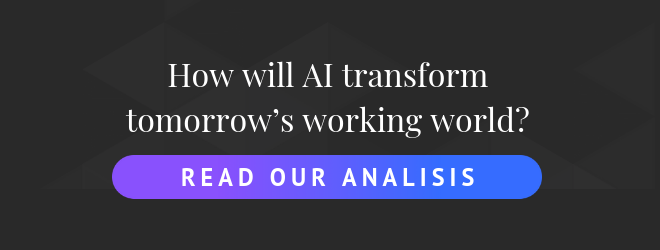In recent years, artificial intelligence has gained the ability to converse with humans, in written or oral form. This ability makes it a valuable asset at work and in everyday life.
The undisputed star of the last Web Summit in Lisbon was not a young entrepreneur from Silicon Valley, a Bitcoin guru, or even a politician, but a young woman named Sophia, who, in a 15-minute interview on the main stage, amazed, entertained and slightly disturbed the audience who came en masse to the event.
The interview captivated the crowds and created a press frenzy because Sophia is not a human, but rather an anthropomorphic robot designed by the Hong Kong-based company Hanson Robotics. The company is famous for its robots based on Albert Einstein’s research and author Philip K. Dick’s science fiction works. With Sophia, the company created a machine capable of (almost) conversing naturally with a human, bouncing off of questions asked of it, sometimes showing humor, and stumbling only on a few abstract questions.
Though this type of robot is not yet close to being massively commercialized, it is a symbol of a new era, where chatting with a computer has become an almost banal activity. Instead of typing in a Google search, many smartphone users have gotten into the habit of asking Siri or Google Now directly for the next day’s weather report or the result of the previous day’s match, just like you would ask a friend. Owners of Amazon Alexa or Google Home speakers know how easy it is to ask artificial intelligence to launch a playlist or timer. In addition, dialogue with artificial intelligence is not limited to voice: It is becoming more and more common to see a discussion window open on website landing pages, with a chatbot offering information. From making appointments to remote medical monitoring and driving assistance, conversational artificial intelligence is able to accomplish more and more tasks.
The dawn of artificial intelligence
In the middle of the media buzz, it is sometimes difficult to find one’s way around, to distinguish between fantasy and reality, and understand the difference between what technology can do today from what it will (perhaps) be capable of doing in the future. Though artificial intelligence has suddenly pervaded headlines in recent years, let us first recall that, just as the Roman Empire took more than a day to build, this technology did not just appear. It is in fact a rather old discipline, whose origins go back to the post-war period. It all started in 1950, with a research paper by Alan Turing. The scientist sets the stage for a new discipline, aimed at building intelligent machines, and the means to put this intelligence to the test. From the outset, this technology is closely linked to dialogue. Indeed, the article also explains the principle of what will become the famous Turing test: for a machine to be considered intelligent, it must be able to converse with a human without the latter realizing that it is dealing with a computer.

During a summer session at Dartmouth University in 1956, the term “artificial intelligence” was definitively adopted to designate this new discipline, which aims to design machines capable of performing tasks that are usually the prerogative of humans. Six years later, computer engineer Joseph Weizenbaum developed Eliza, the first ever artificial conversational agent. Named after a character in George Bernard Shaw’s Pygmalion, this computer program is able to have a basic oral and written conversation with humans, thanks to 200 lines of code. The enthusiastic reaction of the individuals chosen to test the program shows that humans are ready to interact naturally with computers. But the technology remains far from advanced enough to make this possible.
Conversational AI Driven by the Age of Smartphones and Deep Learning
the smartphone. A growing number of Internet users have started surfing the web from their phones, to the point that by 2016, the number of people connecting to the Internet on mobile or tablet surpassed that of people using their computers for the first time. The difficulty of making websites as navigable on smartphones as on computers has led to the explosion of applications. This boom has led to a tremendous user appetite for messaging services. Facebook Messenger and Whatsapp (which also belongs to Facebook) are the two most popular applications in the world, while in China, a super messaging application, WeChat, provides access to a whole range of services, whether it’s ordering a taxi, checking your bank accounts or getting a pizza delivered. A model that Facebook now wishes to draw inspiration from for its own applications. Messaging is thus gradually establishing itself as a new interface and as a new way of accessing services.

At the same time, advances in artificial intelligence have led to tremendous advances in speech and text recognition thanks to progress in deep learning (which allows machines to learn by themselves and is inspired by the functioning of the human brain). For the first time in human history, machines are able to understand what we are saying, and answer us.
The combination of these two trends opens a path to a new era of computing, marked by the proliferation of conversational agents and a kind of intelligent messaging. Today, they communicate directly with humans, most often in writing, but also orally, to access their desires. These conversational agents gradually replace the mouse to inaugurate a new way of controlling computing and accessing a whole bunch of functions. No need to click, type in a search bar or navigate through a plethora of menus. Speech, an ancestral tool developed by men to communicate, once used by Socrates to teach philosophy, now reigns over the digital age. These conversational agents are divided into two broad categories: chatbots on the one hand, and virtual assistants on the other. Although one is often used to refer to the other, the two terms refer two quite distinct realities.
Chatbots vs Virtual Assistants
Chatbots are computer programs that communicate through instant messaging, whether by text message, on Facebook Messenger or via website chat. These are often quite simple programs, with limited functionalities, designed to inform the user about a specific task. This can include helping motorists challenge illegitimate parking tickets, ordering a coffee at Starbucks, or navigating a commercial site.

Virtual assistants are, as their names indicate, real personalized assistants. Unlike chatbots, they are designed for long-term use by an individual, and are able to learn to adapt to their habits and preferences. They are therefore more “intelligent”. Vertical virtual assistants are designed to perform a specific task, such as organizing appointments, managing your mailbox, or looking for a job. Horizontal or general assistants, like Alexa or Siri, are in charge of assisting their owners in various tasks of daily life. The latter are very versatile: Alexa passed the 25,000 different “skills” mark last December in the United States. They are also used to control connected objects: eventually, these generalist virtual assistants will serve as universal connectors to control an abundant and harmonious ecosystem of intelligent objects. Thanks to them, the computer becomes thus invisible, disseminated in the whole of the objects of everyday life.
The art of conversation
But before getting to that point, let us remember that conversational artificial intelligence remains for the time being limited, and highly dependent on man. The dialogues of Google Home and Cortana, the generalist virtual assistants of Google and Microsoft, are written by writers, poets and playwrights. Specialized virtual assistants remain under human supervision, with technicians on the lookout for the slightest bug, while chatbots pass the task onto a human operator as soon as a request becomes too complex. Artificial intelligence struggles to understand slang, familiar language and irony. In short, these conversational agents complement humans rather than replacing them.
Specialized virtual assistants remain under human supervision
“Some requests are simply too complex to be processed by a machine. Others do not call for a factual answer, but rather a touch of humanity, which artificial agents are unable to bring,” says Ben Lamm, co-founder of Conversable, a platform that allows companies to build their own conversational agents. “Let’s take the example of a chatbot employed by an airline company. Whether it’s confirming a plane’s schedule, buying a ticket or knowing if animals are allowed on board, the bot can easily handle it. On the other hand, if the consumer is angry because his flight has just been cancelled and he cannot make it to his daughter’s wedding in Nebraska, it is up to a human to take care of him. And since you can never know where the conversation is going to lead, you need human supervision, allowing the customer to switch to a flesh-and-blood operator,” he explains.
When technology advances, however, will we be able to dialogue with a conversational agent as naturally as with one of our friends ( as seen in the film Her ). “I don’t think that’s where the technology is going. The most important function for intelligent bots and assistants is not to make conversation, but to act to respond to a request. So, rather than becoming more human in the way they speak, they will be able to solve our problems as well or better than a human. This implies developing emotional intelligence, based on the human model, and accessing a wide range of information and protocols that a human brain could not memorize. It is more likely that men will learn to make the most of their interactions with artificial intelligence, rather than the latter perfectly copying our modes of interaction.” More like Robby the robot than C-3PO, after all.

